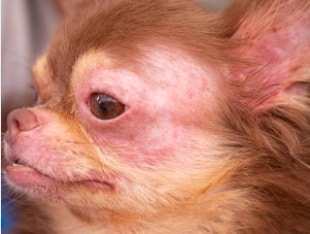January 26, 2022 by Dr. Sigrun Hackl

Fluffy is wearing doggy boots on all four paws, they make him walk funny, but they stop him from constantly licking his feet. He is also wearing a t-shirt, to cover his near hairless body and stop the constant scratching. The owner has all but given up on trying to stop him from scratching. They feel it’s impossible and that they have ‘tried everything’. But have they really? And is this fair on Fluffy, who can’t help it, feels itchy, and now can’t scratch it?
Allergies can be a huge challenge, physically, mentally, financially, on all involved. Diagnostics can be tedious, and lapses and fallbacks are frequent. So what to do?
To me, the key to successful management is in the understanding of the condition, the possibilities, the impossibilities, the loopholes, the traps. What makes one thing work, and the other not? How do we know?
Let’s start with a bit of background, just a short excourse into the realm of immunology. What happens during an allergy?
Basically, the body starts creating an allergic reaction to something that is actually ‘normal’ or ‘harmless’. This reaction triggers the release of histamines, which in turn, create the itch. The patient (dog, cat, human, horse… ) starts scratching, sometimes so severely that the skin breaks and an infection settles in on top. Now we have the perfect vicious cycle: Inflammation and bacterial infection keep the reaction going.
So here we have the first important understandings:
An allergy is a LEARNED reaction, where the body starts reacting to a substance that it had contact with before (it may be the 2nd contact, but it is never on the first) scratching makes everything worse, so we need to stop the scratching With #2, the challenge starts. How do we stop them from itching? For sure, there is the ‘oven glove’ method (in case of pets more likely Elizabethan collar, shirts or boots). But have you ever been itchy and told not to scratch? The stress that comes with this is considerable!
So better to find the course and eliminate it!
Which presents us with the 2nd challenge: how to eliminate an allergy?
It’s impossible, right? Not quite.
For further exploration, let’s differentiate between food allergies, and environmental allergies (so called atopy), as their management differs somewhat.


Let’s start with atopy
The body reacts to some substance in the environment. Since this can be literally ANYTHING, finding out can be hard to impossible. Deduction and logic can sometimes narrow it down a bit, but conclusive results depend on either very thorough ‘trial and error’ testing, or, faster and more convenient, allergy tests. While gold standard testing would be an intradermal allergy test, this is often not practical as it requires application of intradermal injections under anaesthesia. A good alternative can be the allergy blood test, that checks a broad panel of common allergens (while the body can literally decide to become allergic to anything, luckily, there are some ‘favourites’ that make it easier for us to identify the main culprits). This blood test gives us guidelines on what to avoid / eliminate out of the patients’ environment. It also gives us the option of active immunization, the only ‘true cure’ for an allergy.
Active immunization is based on the animal’s blood results and tailor made for the individual. It is a vaccine that includes all the allergen triggers for this patient, and is given in very small amounts and frequent intervals (at home). The idea is to teach the body a ‘better’ reaction to the allergen, and thus neutralize the trigger with a helpful immune response rather than setting off the trigger and histamine release. With successful active immunization, allergies can be cured in most cases.
With successful identification of allergens, many allergens can be avoided, and if done with consistency and diligence, the problem can be kept under control.

Now let’s look at the food allergies
While there is a blood test for food allergies, the correlation between results and actual disease is, unfortunately, rather low. Therefore, in the case of food allergies, the gold standard is still the elimination diet. Here, the due diligence and care are of the utmost importance and often misunderstood or overlooked!
Let me ask you something. Have you ever seen the note ‘may contain traces of peanuts’ on some products that actually do not contain peanuts? Have you ever wondered why? Not if you know someone with a peanut allergy!
While many allergies are somewhat ‘dose dependent’ and more severe with more exposure, even traces of the offending substance CAN be enough to trigger reactions.
So if we look at an elimination diet, the first rule is NO EXCEPTIONS. no treats, no snacks, no other food, no ‘cleaning under the table’ or ‘being friendly with the neighbours’, no dental chews…. basically NOTHING other than the chosen diet for the entire length of the feeding trial. Because each and every item can trigger a reaction and spoil your results, making it look like ‘ we changed the food already, but it didn’t do anything!’
The next thing to understand is that reactions can be quite delayed, and especially in the cases of severe skin infection, the symptoms can carry on well beyond the actual exposure. Meaning the trial must be 8 weeks, and 8 weeks diligently following the rules. The only reason to change diet in less than 8 weeks is that symptoms are getting worse on the chosen diet.
So how do we choose the diet? In order to avoid triggering more allergies, the diet needs to contain protein from a known safe source (which is impossible, as we are trying to find out which one it is), or protein from a completely new source (remember that above paragraph about learned reaction?). The pet food industry has given us a 3rd option by ‘pre-digesting’ the protein in the food and breaking it down into its basic parts (amino acids), so that the body will no longer recognise it as ‘chicken’ or ‘beef’. These are the hypoallergenic diets that based on protein hydrolysates.
The next aspect about the diet is that any protein can trigger allergies, though most commonly it is the animal protein that triggers. Still, the safest diets have limited ingredients to decrease the number of potential triggers (I always like the very short ingredient lists). So we are looking for a hydrolysed or novel protein source, a short ingredient list, an easily available food (as this is likely going to be for life) and a flavor that the patient is likely to accept. No challenge there, hey? Luckily, options are plenty these days. And not all is bad.
If we go for a novel protein source (say, venison), then we CAN still use treats, as long as they are PURE protein of the same source (ie dried venison meat). This way, life doesn’t become too boring for the next 8 weeks.
So how do we proceed?
We change the diet, we get the whole family involved, we dedicate ourselves to being really strict with this, and we watch the patients response. In dogs, the most common signs of food allergy are itchy feet and itchy ears (consequently, ear infections and brown staining on the paws from constant licking). Are those getting better? Or worse?
And once we have a diet that works, stick with it. Avoid variety. It sounds boring to the human brain, but allergies can change and NOT using all those other novel proteins gives us a backup plan, just in case we may need to find something else in future.
Oh, and some general misconceptions: allergies have nothing to do with quality. The best quality organic peanut can put an allergic person in hospital, while the worst quality food – well, may probably cause other issues, but is no more nor less likely to trigger an allergic reaction than anything else. And if all that fails?
If you have already put Fluffy on hydrolysed food and he is not getting the teeniest little treat ever and you have done all the allergy checks and the immunization and he still has other allergies that we just cannot identify?
Well then, the way to go is to manage the symptoms, meaning suppress the itch with medication. There are different products now, usually tablets, that will alter the body’s reaction and stop the itching, so that, at least, Fluffy and family can be at peace. Fluffys hair can grow back and his skin can heal. Unfortunately, these medications need to be given for life. However, this is still the better option, other than suffering that stressful itchiness all the time, don’t you think?
IMPORTANT: allergies are MANAGED, not cured. Therefore, all measures have to be kept up for life and any lapses or slips can lead to a return of symptoms. Even in well managed cases, flare ups are common and to be expected. The idea is to keep the symptoms to a minimum and allow for good quality of life for all involved.

Veterinary Surgeon

Be the first to know about exciting promotions, special discounts, and essential updates.
This website uses cookies to ensure you get the best experience on our website.